Samsung Galaxy S 5 Review
by Anand Lal Shimpi & Joshua Ho on April 8, 2014 12:00 AM EST- Posted in
- Smartphones
- Samsung
- Mobile
- Galaxy S 5
Display
As the smartphone market continues to mature, the distinguishing between smartphones becomes harder and harder as OEMs continue to converge in platform and in most other aspects. This is most evident when looking at the progression from the Galaxy S2 generation to today. Back then, the Galaxy S2 was notable because of its Exynos 4210 SoC, which was far ahead of Qualcomm’s dual core Scorpion solutions at the time, which meant non-Samsung OEMs had notably worse CPU and GPU performance. The same was also true for the original Galaxy S with its Hummingbird SoC. Today, just about every OEM ships the same SoC. The difference between 8974AB and 8974AC is effectively only an eight percent CPU bump for the AC variant.
One of the key differentiators now in the market is display. The Galaxy S 5 features a 5.1-inch 1080p Full HD Super AMOLED display, equipped with the usual set of software defined color profiles. The GS5 gets a new adaptive profile that automatically adjusts the tint of the display according to the color of the ambient light. It's a neat effect, however Samsung's Cinema mode still ends up being the most accurate.
As always, we measure color accuracy using Spectracal’s CalMAN 5 software and a custom workflow for smartphones and tablets.
The results show that the Galaxy S5 has a display that is dramatically improved from the Galaxy S4. However, the Galaxy S line doesn’t exist in a vacuum, so it’s important to also look at how it compares against the best LCDs in other phones. In this department, things aren’t quite as perfect. To start, the color gamut control is still rather poor even on Cinema mode, as effectively all of the secondary colors miss the sRGB targets for saturation sweep. Yellow, cyan secondaries and green primaries are also notably out of the sRGB gamut triangle. While recent headlines have raved about the Galaxy S5’s record-setting color accuracy, I don’t see this at all in the results. Still, against the competition in the Android space, Samsung has improved a tremendous amount while other OEMs seem to be stagnating or even regressing in color accuracy. The only Android OEM that actually beats Samsung in the color accuracy department is now Google, which is strange because they contract out their hardware to other Android OEMs.
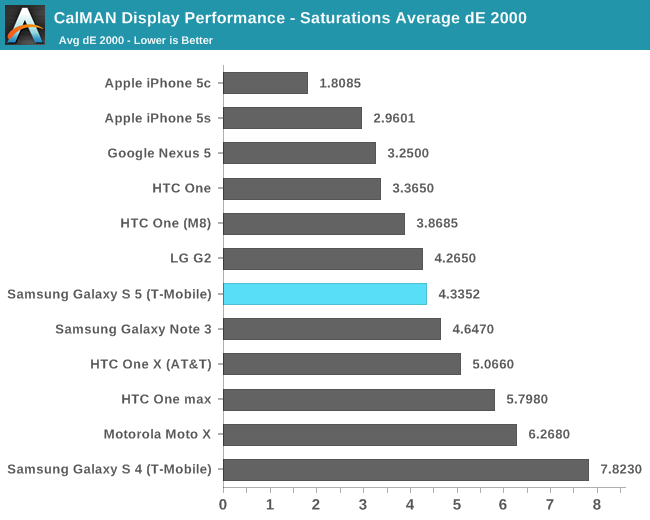
Looking at the saturation sweep, it’s evident that Samsung is now about equivalent to LG in color accuracy for their displays. HTC is barely ahead, with such a small difference that it’s not worth counting. Only Google and Apple have a noticeable lead in this department, a huge improvement from 2013 when Samsung trailed far behind most other competitors in this test.
In the Gretag Macbeth Colorchecker, Samsung continues to hold its position, beating all but Google and Apple. HTC is noticeably behind in this department compared to Samsung, as the One (M8) is horrific in this department compared to even the original HTC One.
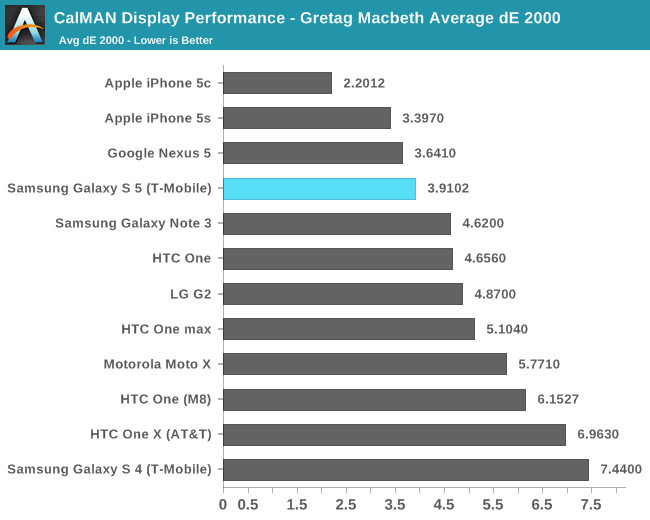
In the contrast department, Samsung continues to dominate, with effectively infinite contrast. Based upon some quick viewing of the display in the darkest room I have in the house, I don’t see any obvious DC bias issues. Unfortunately, I still see some ghosting on the display at low brightness which manifests as a purple trail when scrolling. This seems to be unchanged from the Galaxy S4. The minimum white brightness is around 1.8 nits, which is great for reading at night, as many LCD-screened phones such as the LG G Pro 2 have a minimum white brightness of around 7-12 nits.
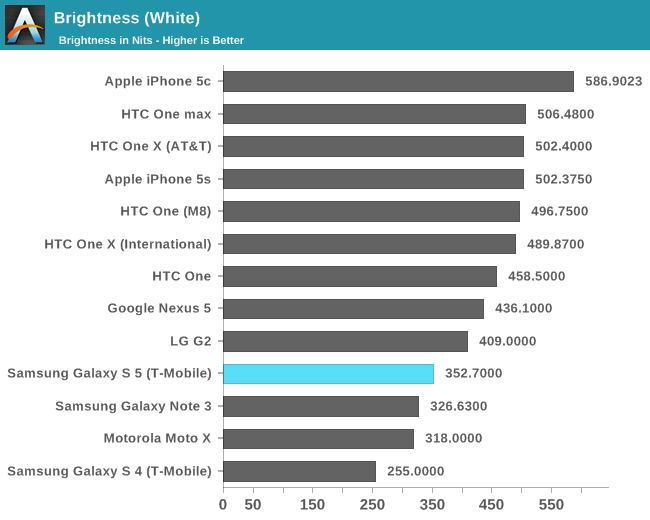
Samsung has also made great gains in the maximum brightness department, which is especially pleasing because for the longest time, AMOLED was noticeably less bright which made it incredibly difficult to read webpages and similar content outdoors. I’m happy to say that this is no longer the case, as the Galaxy S5 now has a display that realistically reaches around 440 nits outdoors with a pure white image, although this requires auto-brightness to be on and will vary with the screen mode. The maximum that is accessible without this daytime boost mode is somewhere around 350 nits.
The problem is the way Samsung has achieved this, something that is shown in the grayscale tests. While Samsung has done a great job in clamping down the white point to around 6504k, grayscale is so noticeably green that not only does CalMAN show this in the measurements, but also casual observation. I can literally see that the grayscale image is not gray, but an off-green. I’m not quite sure how this happened, but I suspect that this was done in an effort to increase peak brightness as even in the bluest display mode, green is still closely tracking with blue.
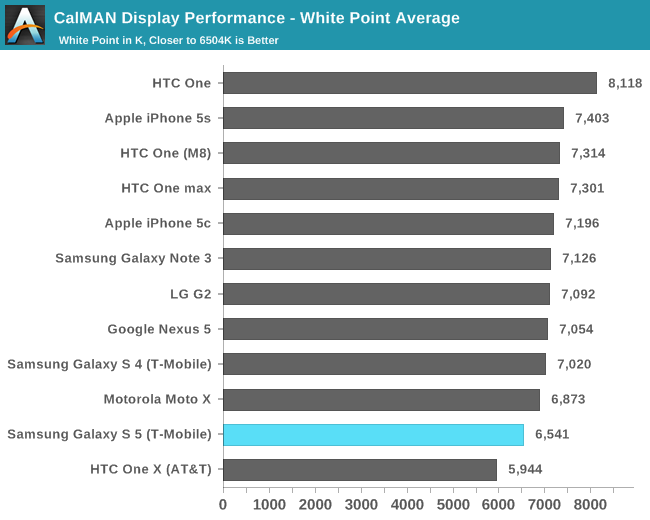
Overall, I’m quite pleased with the display. The AMOLED display in the Galaxy S5 is finally equivalent to LCD displays in color accuracy and peak luminance, areas that LCD used to be the best in. Throw in the incredible contrast that AMOLED has always had and the ability to toggle between wide color gamut and accurate color, and I would say that AMOLED is finally equal, if not slightly better than LCD. With a few more iterations, I wouldn’t be surprised if I were to write that AMOLED is clearly superior to LCD. Of course, there are some issues such as a noticeable green tint to the display in grayscale and Samsung still needs to improve their clamping of gamut to sRGB for Cinema/Movie mode, but none of these issues seriously detract from the viewing experience.


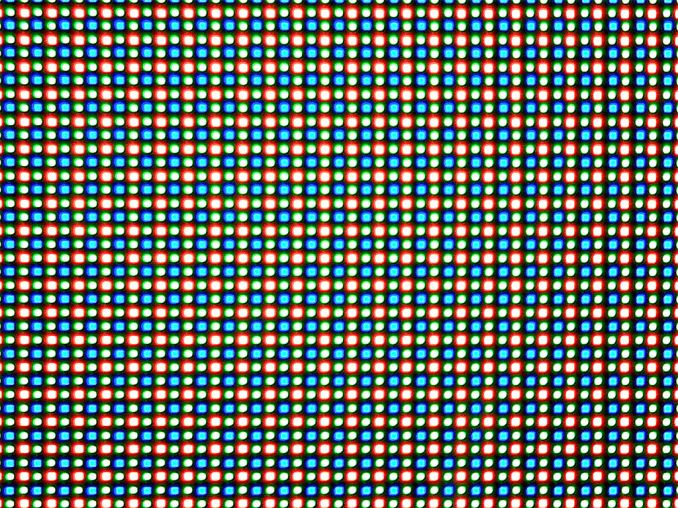












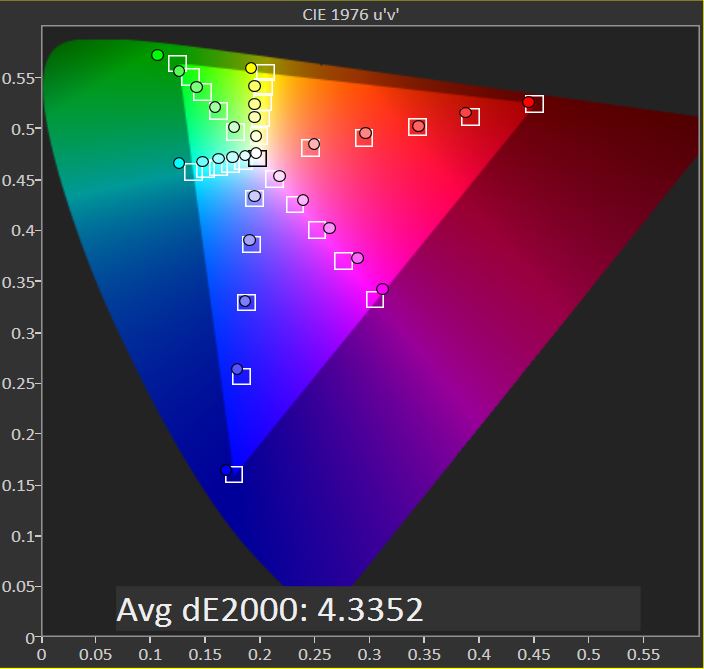
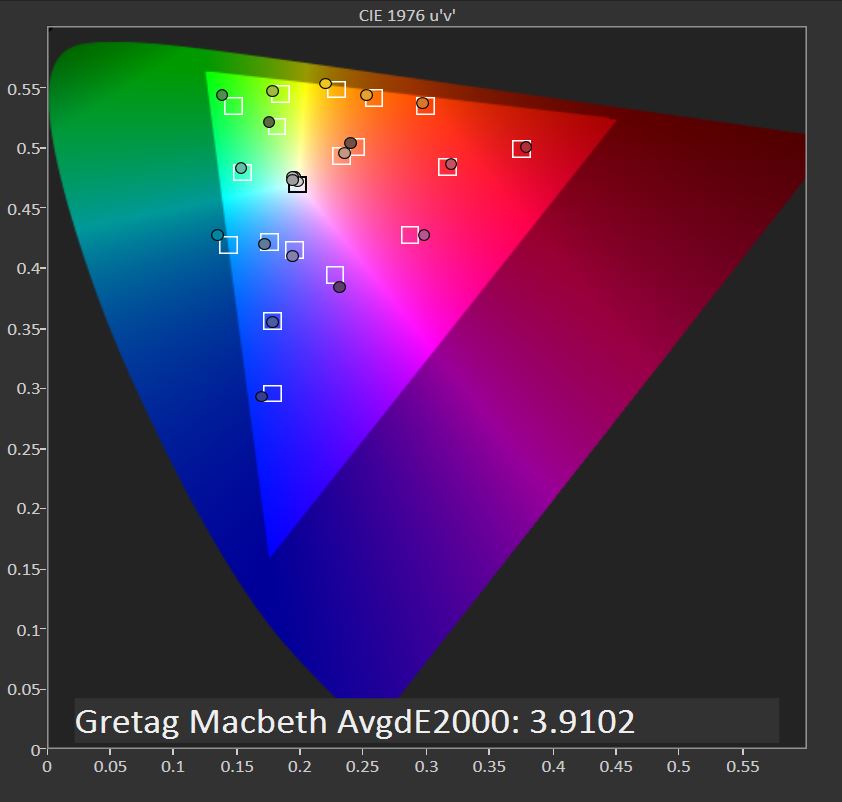









296 Comments
View All Comments
Brian Z - Wednesday, April 9, 2014 - link
Yes you are a obvious fanboy.I have not said nor has anybody else said that Samsung wad the only one.
Hell this site has a theme going up where they update the benchmark cheating chart. But yet you still push your BS.
And Samsung was the only OEM to actually overclock the gpu. But since it's Samsung you got the nerv to even suggest well is it really cheating....
They complained loud and clear about this. In public on the reviews. In public on the podcast. Even in public we want Sony to send us a phone so we can see if they are cheating and add them to the chart
And now they are advertising the m8 in the article. So I guess you weren't paying any attention ever when a review compared different SoCs bins. Like the Samsung Galaxy s4 with its 1.9ghz s600 in the nexus 7 2013 article. Funny how that isn't advertising. Or when comparing screens on the tablets in the market. But of course you're a blinded fanboy so yeah.
They "discovered" the cheating not because it was Samsung. Because somebody on twitter Tweeted at Brian Klug and they investigated it from there. They weren't even looking for it period. And what did they do right after testing it on the Samsung device. Look at all the other players in the market to see if they were doing it. But facts and reality don't matter a delusional fanboy like yourself.
Oh and keep telling yourself aluminum is cheap crap. Aka a beer can.
Clueless uninformed pathetic fanboy
doobydoo - Friday, April 11, 2014 - link
TheSailorMan - you can't go round spouting fanboy crap such as iAnand and expect to be able to claim you're not a fanboy. You're worse than anyone else I've seen.TheSailorMan - Sunday, April 13, 2014 - link
I REPEATI'm not fan boy to any brand!!!!!
And you hippocrates, do not lie, that this all BS was not meant OLNY for bashing Samsung .
Even here iAnand mention AGAIN Samsung slyly, but didn't mention it about HTC (they even did it again with M8 , and didn't give a sh.... about iAnand "discoveries", saying that it was NOT cheating )
Veruca5alt - Monday, April 28, 2014 - link
http://en.wikipedia.org/wiki/HippocratesVeruca5alt - Monday, April 28, 2014 - link
bahahahhaha what a trolltastic fanboy you arepuremind - Tuesday, April 8, 2014 - link
Good job on the display analysis this year guys. Last year theS4 review did not go into the dynamic brightness adjustment issue and I feel you have nailed this down this year.Though it would have also been nice to see the maximum brightnes in boost mode not only for 100% white but for an APL of 80% which is the average APL of web browsing content. It will probably be in the region of 500cd/m² based on the curves I measured last year.
http://forum.xda-developers.com/showthread.php?t=2...
If you look at the curves I produced and typical brightness for content at different APL levels, it shows how brightness progresses.
- On the S4 it decreased from 478cd/m² at 1% APL down to only 283cd/m² for a 100% white picture, so a 60% loss.
- On the S5, displaymate noted 698cd/m² at 1% APL and you noted 440cd/m² at 100% white, which is also about 60%.
-Based on the apparently same progression and prorating my results from last year, at 80% APL we should still have 475 cd/m2 for web browsing, which is very close to the HTC One (approx 500cd/m², through this also varies with APL). For video content and some web content we should actually see brightness well above 500cd/m².
You certainly did a much better job than Displaymate in terms of objectivity.
TheSailorMan - Monday, April 14, 2014 - link
"You certainly did a much better job than Displaymate in terms of objectivity."Really? Better job than Displaymate? LOL
iAnand did his job AGAIN.
Human Bass - Wednesday, April 9, 2014 - link
The really iffy thing I found about the S5 was the lack of OIS in the main camera.TheSailorMan - Monday, April 14, 2014 - link
Still one of the best on smatphones(if not the best)Blairh - Wednesday, April 9, 2014 - link
S5 reminds me a lot of the S4 Active which I used last year. Sucks to see HTC and Samsung go bigger and heavier this year.I have the Nexus 5 and I'll never pay more than $350 off contract for a phone ever again. 30 grams less than the N5. Speaker is fine for short YouTube vids. I use bluetooth speakers and headphones in all other situations. Camera is solid after 4.1.1. Lack of SD slot is a letdown but I pinned my favorite music. Feels amazing in hand. Stock Android. Can't recommend it enough. $300 less than S5 and M8 off contract. And AT&T saves me $15 a month for bringing my phone to their service.